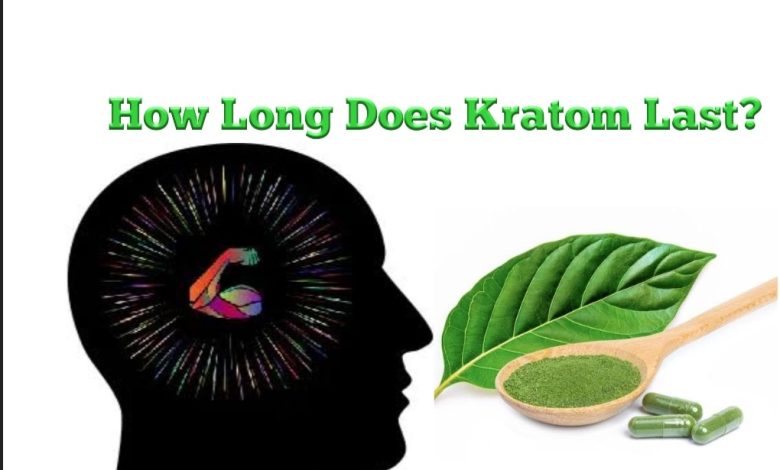How Long Does Kratom Last?

Kratom, scientifically known as Mitragyna speciosa, is a tropical evergreen tree native to Southeast Asia, particularly Thailand, Malaysia, Indonesia, and Papua New Guinea. The leaves of the kratom tree have been traditionally used for their medicinal and recreational properties in these regions for centuries.
Kratom leaves contain several active compounds, including mitragynine and 7-hydroxymitragynine, which interact with opioid receptors in the brain, producing effects that can vary depending on the dosage and strain. In low doses, kratom is often reported to have stimulating and energizing effects, while in higher doses, it can act as a sedative, providing pain relief and relaxation.
Historically, kratom has been used by workers and manual laborers in Southeast Asia to boost energy levels, increase productivity, and alleviate fatigue. It has also been used as a traditional remedy for various ailments, including pain, diarrhea, and opium withdrawal symptoms.
The cultural and historical use of kratom in Southeast Asia has deep roots, with anecdotal evidence suggesting its use dating back several centuries. It has been an integral part of indigenous cultures and traditional medicine practices in the region. In some countries, such as Thailand and Malaysia, kratom use was once prevalent among the working class and was even used as a substitute for opium during periods of scarcity.
In recent years, kratom has gained popularity in Western countries, particularly as an herbal supplement for pain relief, mood enhancement, and opiate withdrawal management. However, its use and legality remain a subject of debate and regulation in many countries. Some jurisdictions have banned or restricted kratom due to concerns about potential health risks and its opioid-like properties, while others allow its use under specific regulations. However, users often have questions about how long the effects of kratom last. In this article, we will explore the factors influencing the duration of kratom’s effects and provide a comprehensive guide to help you better understand this aspect of kratom use.
Understanding Kratom’s Mechanism of Action
Before delving into the duration of kratom effects, it’s crucial to grasp how this botanical substance interacts with the body. Kratom’s primary active components, mitragynine and 7-hydroxymitragynine, bind to opioid receptors in the brain, leading to analgesic, sedative, and stimulant effects. The duration of these effects can be influenced by various factors.
Factors Affecting Kratom Duration
Several key factors influence how long the effects of kratom last:
1. Dosage: The amount of kratom consumed plays a significant role in determining its duration of effects. Generally, lower doses tend to produce more stimulating effects with a shorter duration, while higher doses may result in more sedative effects that last longer.
2. Kratom Strain and Vein Color: Kratom strains, such as red, green, and white vein varieties, exhibit different effects and durations. Red strains are known for their relaxing and pain-relieving properties, often offering longer-lasting effects. On the other hand, white strains are typically more stimulating and may have a shorter duration.
3. Individual Metabolism and Tolerance: Each person’s unique metabolism can influence how quickly kratom is processed and eliminated from the body, ultimately affecting the duration of effects. Additionally, regular kratom users may develop tolerance over time, potentially requiring higher doses to achieve desired effects and prolonging the duration.
4. Potency and Quality of Kratom: The quality and potency of the kratom product can significantly impact the duration of effects. Higher-quality kratom, sourced from reputable vendors, is likely to provide more consistent and longer-lasting effects compared to lower-quality or adulterated products.
General Timeline of Kratom Effects
While the duration of kratom effects can vary among individuals, strains, and dosages, here is a general timeline of the different phases:
1. Onset Phase: After consuming kratom, effects usually begin to manifest within 15 to 30 minutes, although it can take up to an hour for some individuals.
2. Peak Phase: The peak effects of kratom typically occur around 1 to 3 hours after ingestion. During this phase, users may experience the full spectrum of kratom’s effects, such as increased energy, pain relief, relaxation, or mood enhancement.
3. Tapering Phase: Following the peak effects, the intensity of kratom’s effects gradually tapers off. The duration of this phase can vary, with effects typically diminishing over the course of 2 to 4 hours.
4. After Effects: After the tapering phase, some residual effects may persist for a few hours, although they are usually milder and less pronounced.
Individual Variations and Considerations
It’s important to recognize that everyone’s experience with kratom is unique. Factors such as body weight, overall health, and individual biochemistry can influence the duration and intensity of effects. Additionally, certain individuals may metabolize kratom more quickly or slowly, altering the duration of its effects.
Furthermore, it is crucial to exercise caution when using kratom and consider potential risks and side effects associated with its use. Kratom should not be used in conjunction with other substances, such as alcohol or pharmaceutical medications, without consulting a healthcare professional. Mixing kratom with other substances can have unpredictable effects and may pose health risks.
It is also worth mentioning that long-term and frequent use of kratom can lead to the development of dependence and addiction. Prolonged and excessive use can result in tolerance, requiring higher doses to achieve the desired effects and potentially prolonging the duration of those effects. Abruptly stopping kratom use after prolonged use may lead to withdrawal symptoms, further emphasizing the importance of responsible and informed use.
How To Flush Kratom From Your System
Flushing kratom from your system refers to the process of eliminating it from your body. While there is no guaranteed method to rapidly remove kratom from your system, there are a few general strategies that may help:
1. Time: The elimination of kratom from your body will occur naturally over time. The duration can vary depending on factors such as dosage, frequency of use, individual metabolism, and overall health. Typically, kratom may be detectable in urine for up to 1 to 5 days, but this can vary.
2. Hydration: Staying well-hydrated can support the natural detoxification process. Drinking plenty of water can help flush out toxins and promote urine production, potentially aiding in the elimination of kratom metabolites.
3. Healthy diet and exercise: Maintaining a balanced diet and engaging in regular exercise can contribute to overall well-being and potentially support the elimination of substances from the body. However, there is no specific diet or exercise regimen proven to hasten the elimination of kratom.
4. Support liver function: The liver plays a crucial role in metabolizing substances like kratom. Maintaining liver health can indirectly support the elimination process. This can be achieved through practices such as avoiding excessive alcohol consumption, minimizing the use of other substances that strain the liver, and consuming a balanced diet rich in fruits, vegetables, and whole grains.
5. Consult a healthcare professional: If you have concerns about kratom use or need assistance with the elimination process, it is advisable to consult a healthcare professional. They can provide guidance tailored to your specific situation and offer appropriate support or medical interventions if necessary.
It’s important to note that attempting to “flush” kratom from your system does not guarantee immediate removal or affect the detection window in drug tests. The best approach is to make informed decisions about kratom use and consider potential risks and legal implications.
Lastly, it’s crucial to seek professional help if you are struggling with substance abuse or addiction. Healthcare professionals and addiction specialists can provide appropriate support and treatment options.
Conclusion
The duration of kratom effects can vary depending on several factors, including dosage, strain, individual metabolism, tolerance, and quality of the product. Lower doses may produce more stimulating effects with a shorter duration, while higher doses can result in longer-lasting and more sedative effects. Kratom strains and vein colors also contribute to variations in duration, with red strains often providing longer-lasting effects compared to white strains.
It is essential to approach kratom use responsibly and be mindful of potential risks and side effects. Individuals should educate themselves about proper dosage guidelines, reputable vendors, and potential interactions with other substances. Furthermore, it is advisable to consult with a healthcare professional before incorporating kratom into any health or wellness regimen, especially if you have underlying medical conditions or are taking medications.
By understanding the factors that influence the duration of kratom effects and approaching kratom use responsibly, individuals can make informed decisions and enhance their overall kratom experience while minimizing potential risks.





